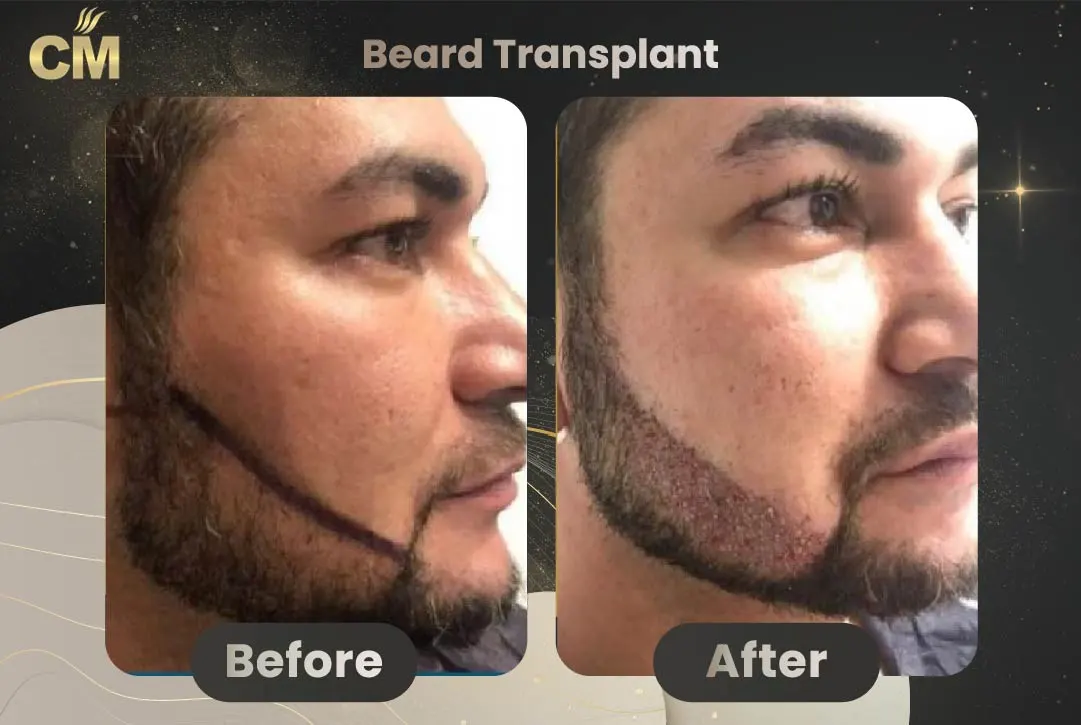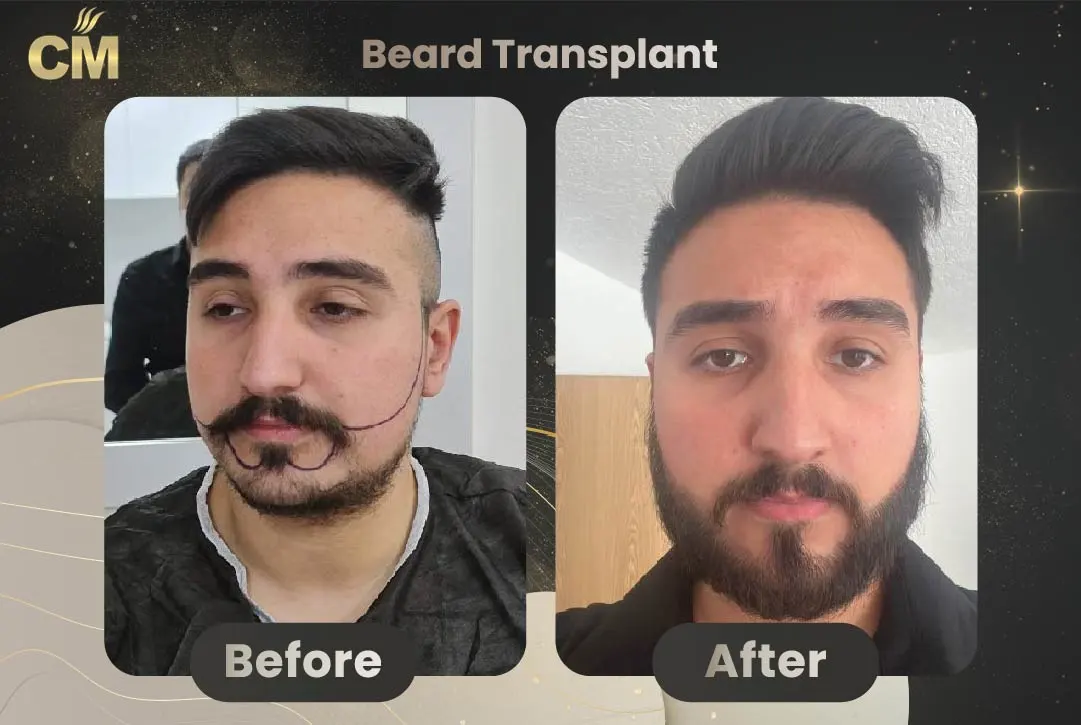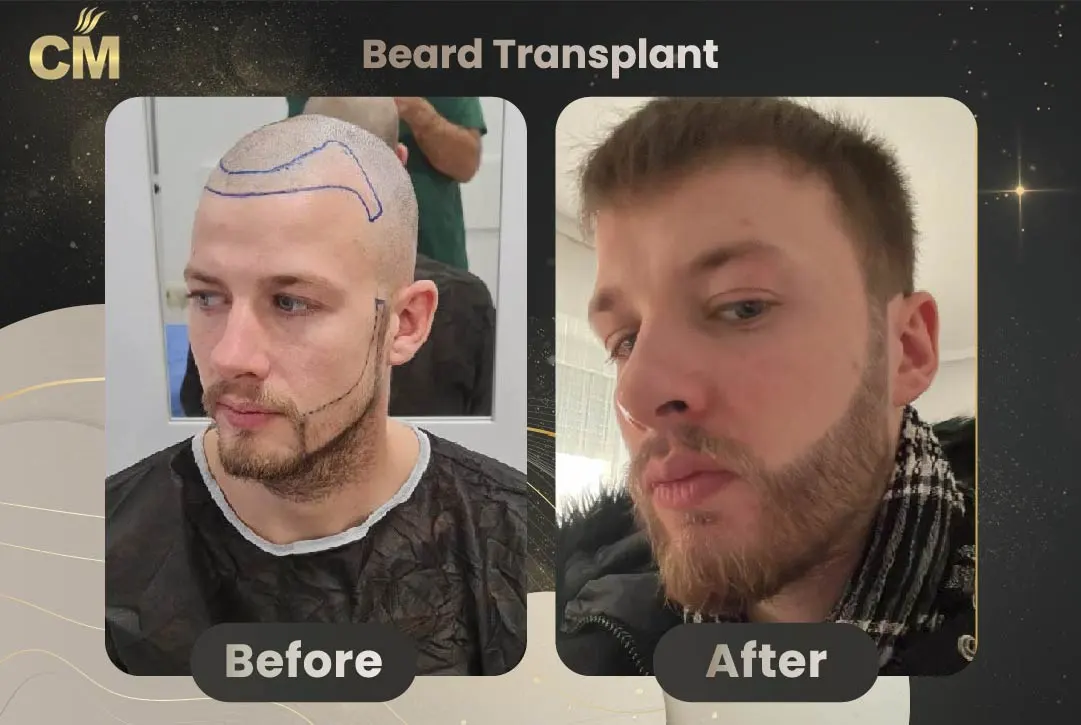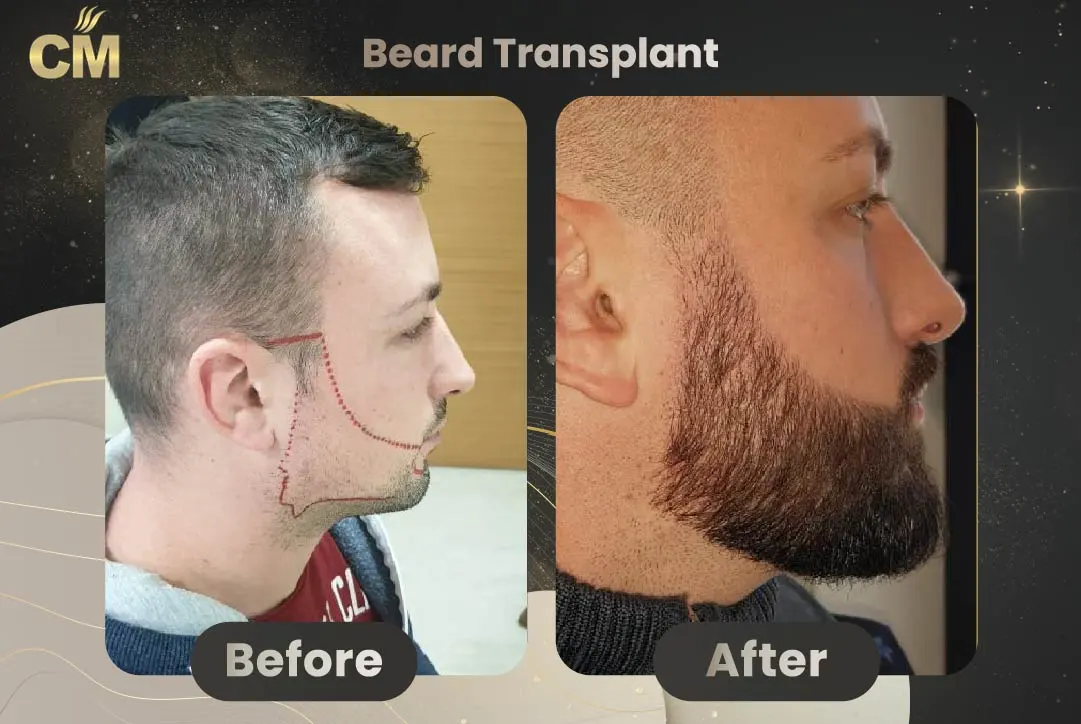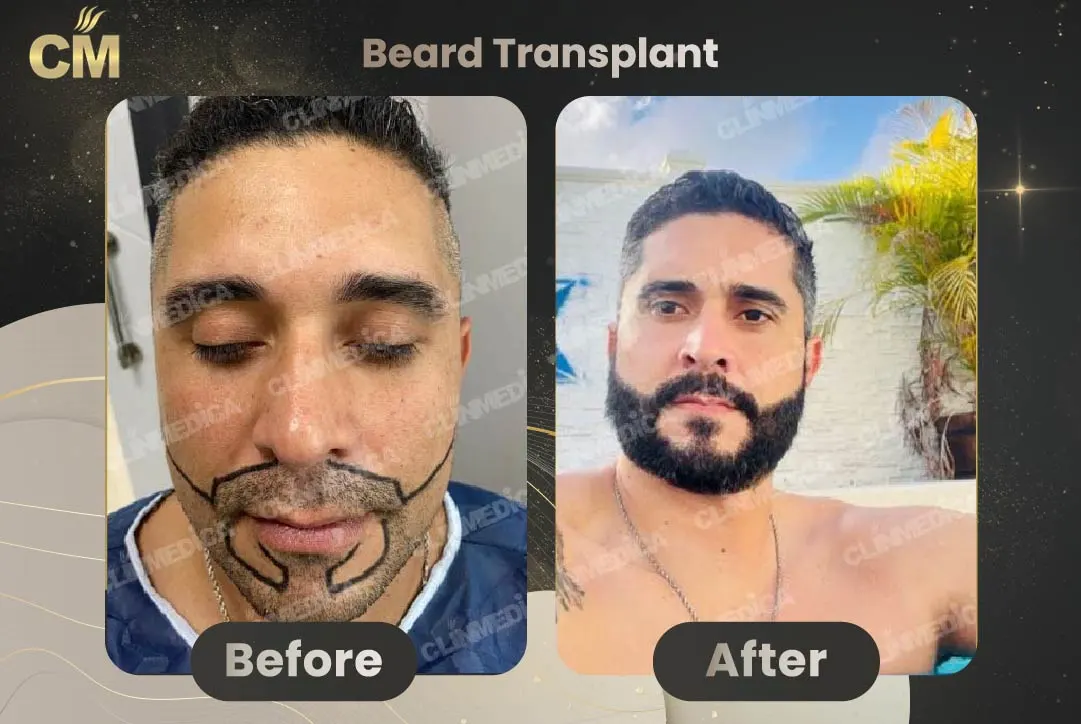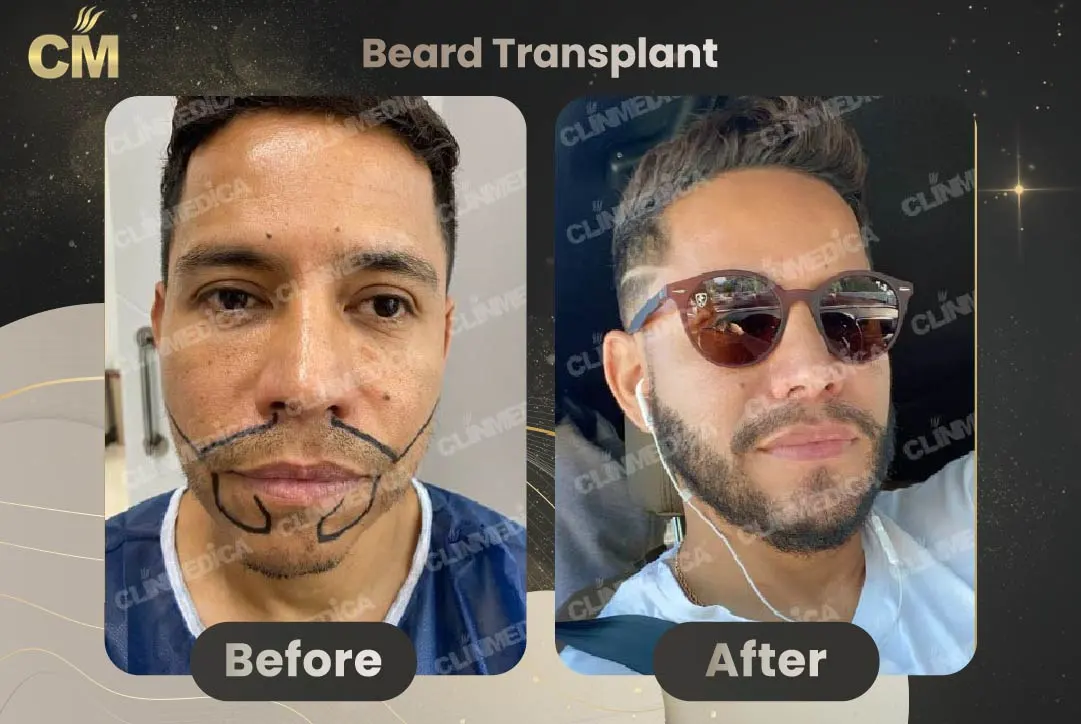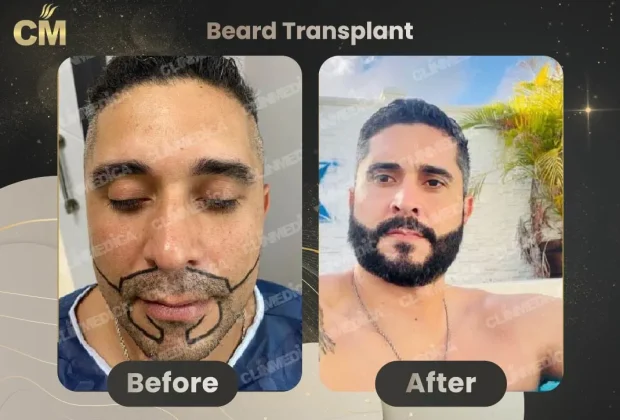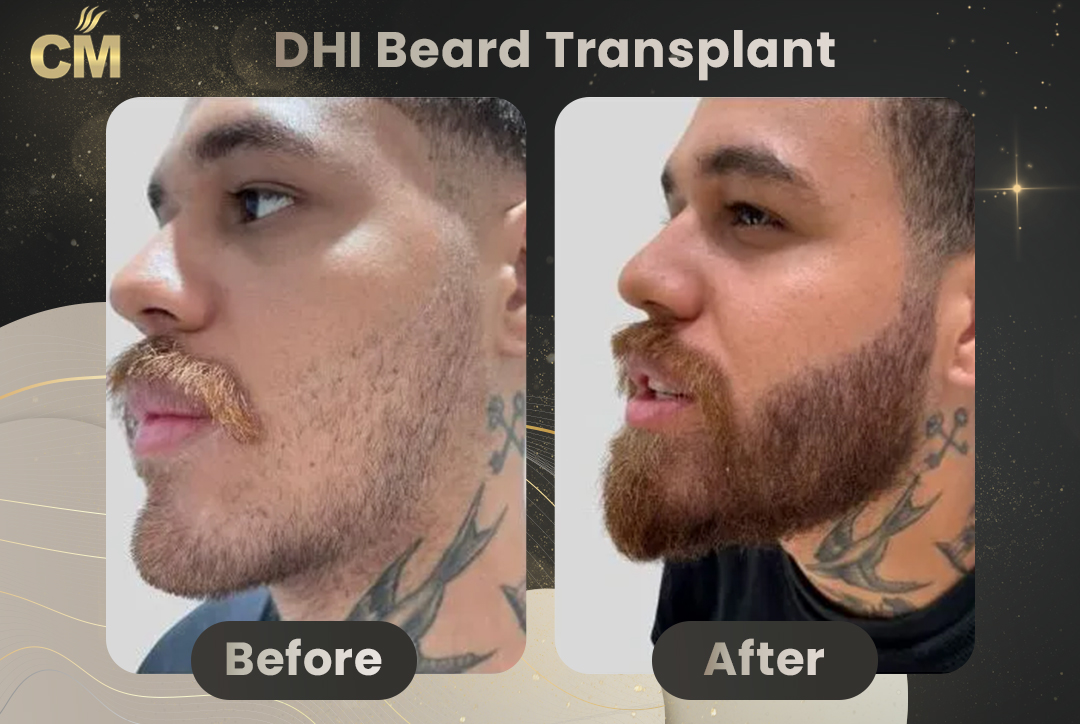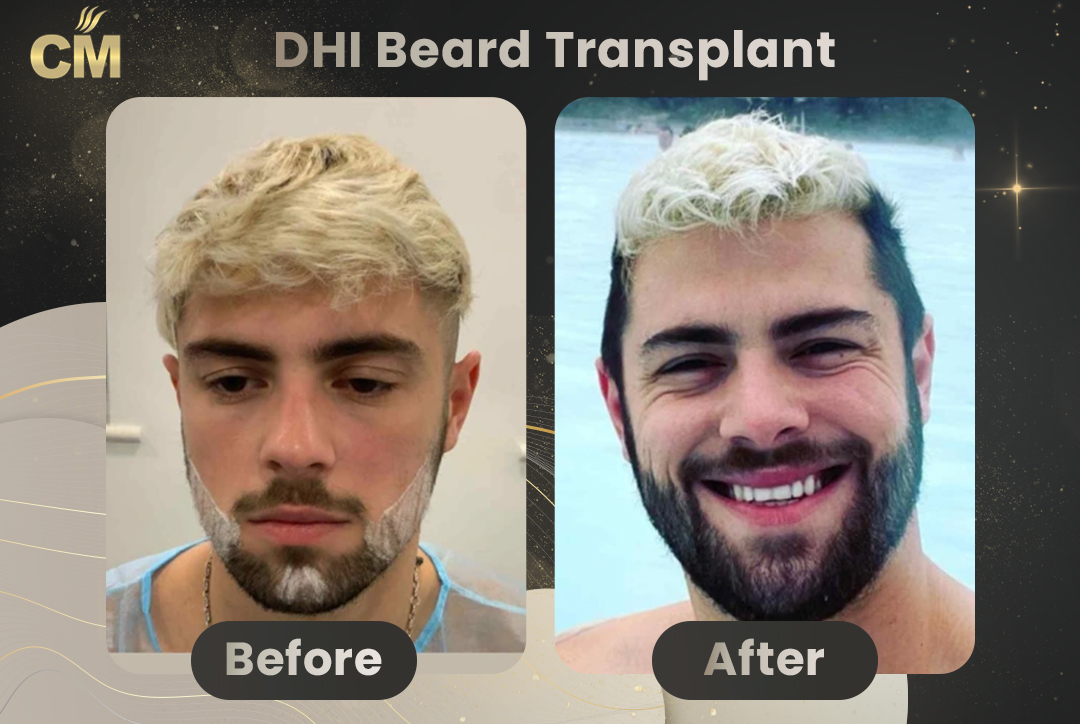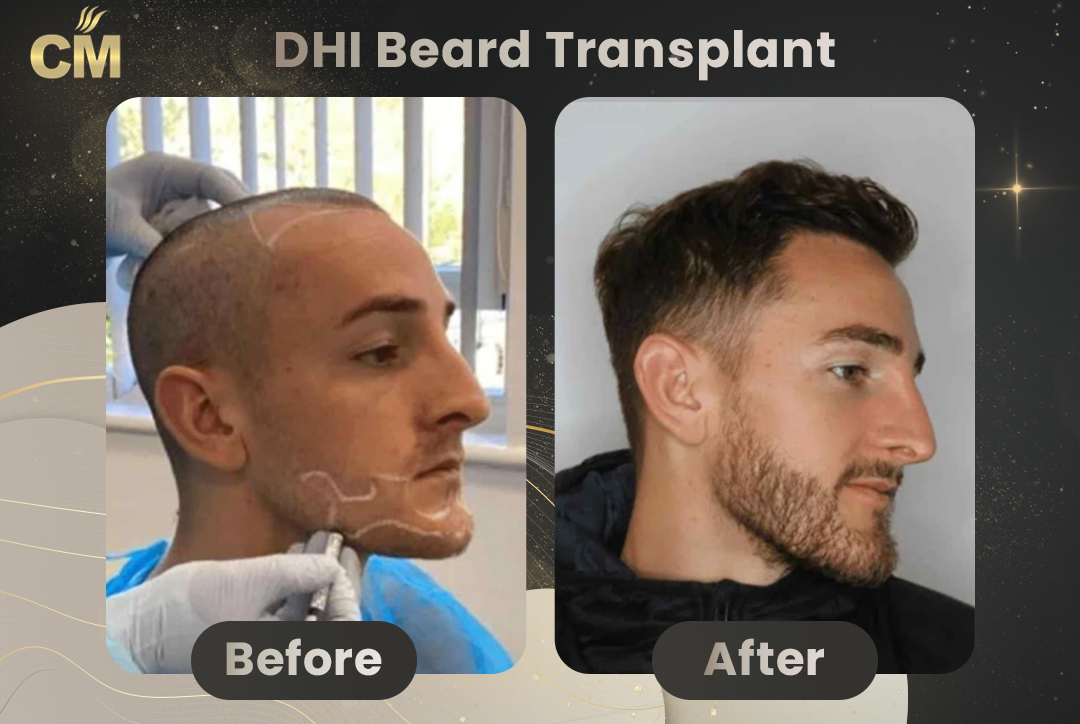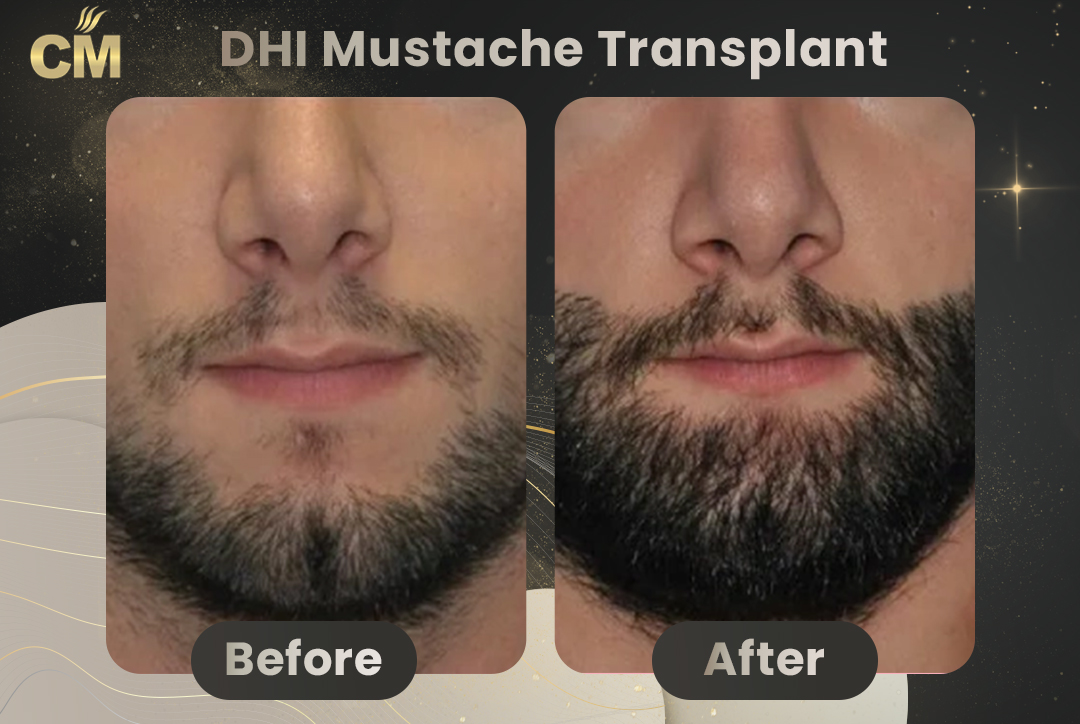Facial hair is a symbol of masculinity, maturity, virility, and wisdom in many cultures. However, some men struggle to achieve a full and dense beard or mustache due to genetic factors like Facial Alopecia. Fortunately, Beard Transplant in Turkey offers a reliable solution. This innovative technique, part of our comprehensive Hair Transplant services, helps men with sparse or patchy facial hair, enhancing their appearance and boosting their confidence.
In this article, you will find pictures showcasing the results of Beard Transplant operations, along with detailed information on how the procedure is performed, and what to expect before and after the process. In recent years, Turkey has become a leading destination for hair restoration, including beard transplants. For many men, a full, well-groomed beard is a hallmark of masculinity and confidence. Unfortunately, not everyone can naturally grow the beard they desire, but beard transplant procedures in Turkey provide an effective solution. Let’s explore how a beard transplant can transform your appearance with remarkable before and after results.
Personalized facial hair transplant turkey Services
Whether you desire rugged stubble, a meticulously groomed beard, or a stylish mustache, our personalized approach to beard transplant meets your unique aesthetic goals. Say goodbye to patchy facial hair and welcome the confidence that comes with a full, luscious beard or mustache.
Techniques of Beard Transplant (facial hair transplant turkey)
Beard transplant techniques include both the Sapphire pen and DHI (choi pens) methods, commonly used for hair transplants.
Similar to hair transplantation on the head, we use the donor area behind the ears in order to extract the follicles using the FUE technique.
Who Is Not a Suitable Candidate?
Although facial hair transplant turkey is a relatively simple operation, it is not advisable for individuals with:
- Cardiovascular diseases
- Uncontrolled diabetes
- Blood-borne viruses such as HIV or hepatitis C
- Lack of a donor area on the back of the scalp
Common Side Effects of Beard Transplant Turkey
facial hair transplant turkey
Common side effects of Beard Transplant Turkey include:
- Shock Loss: Transplanted hair shafts may fall off in the first 3-4 weeks, but implanted roots will continue to produce healthy follicles.
- Itching, Swelling, and Discomfort: Temporary swelling, itchiness, or discomfort may occur in the donor.
- Scarring: With the sapphire pen or DHI technique, scarring is minimal and typically heals within the first few weeks.
How Is Beard Transplant Performed?
After preparing the donor area and applying the necessary local Anesthesia to the donor area, we extract the grafts from the nape or posterior of the head using perforated head micro-motors that work like punches.
After we extracted follicles, we collected them and maintained them in a storage liquid at an appropriate temperature.
so The number of hair follicles needed for Beard Transplant turkey ranges between 1500 to 4000 follicles, but it mostly depends on the patient’s case and whether it is sparse gaps or large areas that we are going to fill.
We transplant the hair follicles to the beard area in a precise manner to ensure a natural appearance.
Is it possible to randomly transplant follicles extracted from the donor area into the beard?
Considering that the hair follicles extracted from the donor area are different, some follicles contain one hair, and some follicles contain two, three, four, and five hairs.
Considering that the area of the beard needing transplantation is often large, it is important to note that follicles containing two or more hairs should not be transplanted on the beard hairline.
This is because only follicles with a single hair should be placed in this line. Gradually, the rest of the follicles can be integrated into the beard. Follicles with two, three, or more hairs can be transplanted progressively downwards until reaching the palate and below it.
Is it possible to grow a beard on the lower neck as well?
Considering that the skin of the face is sensitive and tender, this makes it difficult to transplant hair into the face, but in any case it is not impossible, but it requires greater precision from the doctor. Therefore, we find that beard transplantation sometimes takes longer than hair transplantation on the head.
Therefore, facial hair can be transplanted to a level just below the palate, here we are talking about 3-4 cm below the palate.
Witness the remarkable patient transformation before and after a beard transplant at ClinMedica in Turkey.
Firstly, it is important to note that the doctor cannot open channels in the neck area because it is a sensitive area and the skin there is very thin. Consequently, we conclude that it is not possible to transplant hair into the neck
Beard Transplant Post-Treatment Care
Proper post-treatment care is crucial for optimal healing and results. we provide yours our patients experience guide helps Patients should expect:
- Reddish appearance disappearing within 1-2 weeks
- First wash after 24-48 hours
- Visible beard appearance forming within 2-3 days
- First shave recommended after at least one month
- Potential shock loss 2-4 months post-operation
- Full regrowth and final results within 9-12 months
Beard transplant cost turkey
Turkey is well known as a pioneer in hair transplantation surgeries, with great results and low prices in comparison to other countries of the world. ClinMedica offers you packets that include airport shuttle service – departure, hotel accommodation, medications, transportation, and more, making the beard transplant cost turkey very low.
A base price is often set for beard transplant cost turkey procedures, which may range from as few as two hundred to as many as eight hundred transplanted roots.
Comprehensive Consultation and Planning
Our clinic provides a comprehensive consultation to understand your specific needs and preferences. We discuss every detail, from the desired beard style to the density and thickness you want to achieve. This thorough planning ensures that the results not only meet but exceed your expectations.
Post-Procedure Care for Long-Lasting Results
facial hair transplant turkey Post-procedure care is a priority for us. We offer detailed guidelines to help you maintain and care for your new facial hair, ensuring long-lasting results and continued satisfaction with your appearance.
Natural-Looking Results from Skilled Surgeons
At our clinic, we prioritize natural-looking results that blend seamlessly with your existing facial features. Our skilled surgeons meticulously plan and execute each procedure with precision. By controlling the angle and depth of implanted follicles, we mimic the natural growth pattern of facial hair, ensuring a seamless and natural integration.
Why Choose Turkey for Your Beard Transplant?
Expertise and Experience
Turkish clinics are renowned for their skilled surgeons who specialize in hair and beard transplants. These experts have extensive experience in handling various hair types and textures, ensuring natural-looking results that blend seamlessly with your existing hair.
Advanced Techniques
Clinics in Turkey utilize the latest techniques, such as Follicular Unit Extraction (FUE) and Direct Hair Implantation (DHI). These methods involve extracting individual hair follicles from a donor area (usually the back of the scalp) and meticulously implanting them into the beard area. This ensures minimal scarring and a quicker recovery time.
Cost-Effective Solutions
One of the main reasons people choose Turkey for beard transplants is the cost-effectiveness. High-quality procedures are offered at a fraction of the price compared to Western countries, without compromising on the quality of care and results.
The Beard Transplant Process – Step-by-Step
Consultation and Planning
Your journey begins with a detailed consultation with a hair transplant specialist. During this session, the surgeon assesses your hair growth patterns, discusses your goals, and creates a personalized treatment plan tailored to your needs.
The Procedure
On the day of the procedure, the surgeon will extract hair follicles from the donor area. Using the FUE or DHI technique, these follicles are then implanted into the beard area. The process is meticulous, ensuring that each follicle is placed at the correct angle and density to achieve a natural look.
Recovery and Aftercare
After the procedure, you will receive detailed aftercare instructions to promote healing and hair growth. Mild swelling and redness are normal, but these symptoms subside within a few days. Therefore, it’s crucial to follow the aftercare guidelines to achieve the best results.
Results Before and After
Patients typically begin to see the initial results within a few months, with full results visible after about a year. The transformation can be dramatic, with a fuller, well-defined beard enhancing your overall appearance and boosting your confidence.
Choosing the Right Clinic in Turkey
Research and Reviews
Thoroughly research potential clinics and read reviews from previous patients. Look for clinics with a strong track record of successful beard transplants and satisfied clients.
Surgeon Credentials
Ensure that the surgeon is certified by recognized medical boards and has extensive experience in performing beard transplants.
Transparent Pricing
Opt for clinics that provide clear pricing without hidden fees. Request a detailed breakdown of costs to understand what is included in the procedure.
Comprehensive Aftercare
Select a clinic that offers comprehensive aftercare services to support you through the recovery process and ensure optimal results.
Embrace Your New Look
A beard transplant in Turkey can be a life-changing decision, offering you the opportunity to achieve the beard you’ve always wanted. With the right clinic and expert care, you can experience remarkable before and after transformations that enhance your look and confidence. Don’t let patchy or thin facial hair hold you back – take the first step towards your new look today.
What to Expect After a Beard Transplant
Recovery Process
After undergoing a beard transplant, the recovery process is typically straightforward. You may experience some redness, swelling, or discomfort in both the donor and recipient areas in the first few days. Small scabs will form around the newly transplanted follicles, and these will generally fall off within 7–10 days. Most patients can return to their daily activities within a week, but it’s important to follow the care instructions provided by your surgeon to ensure optimal healing and results.
Resuming Physical Activities After Surgery
It’s recommended to avoid strenuous activities, including sports, for at least two weeks after your beard transplant. Sweating and physical strain can disrupt the healing process and interfere with the grafts settling properly. Light activities, such as walking, are fine within a few days, but always consult with your surgeon regarding when you can resume more intense activities.
Maintaining the Results of a Beard Transplant
Maintaining the results of your beard transplant involves following the aftercare instructions and maintaining a healthy lifestyle. Avoid shaving the transplanted area for a few weeks post-surgery to allow the new follicles to fully integrate. Additionally, using gentle facial care products, avoiding harsh chemicals, and keeping the skin moisturized will contribute to long-term success.
Scarring After a Beard Transplant
Beard transplants, especially those using FUE (Follicular Unit Extraction) or DHI (Direct Hair Implantation) techniques, leave minimal scarring. These advanced methods involve extracting individual hair follicles, which leave tiny puncture marks that heal quickly and fade over time. With proper care, any scarring will be barely noticeable and hidden by the new beard growth.
Understanding the Risks of a Beard Transplant
As with any surgical procedure, there are potential risks, including infection, poor healing, or graft failure. However, choosing an experienced surgeon minimizes these risks. Temporary side effects, such as swelling or redness, are common but subside within a few days. Following your surgeon’s post-operative instructions and attending follow-up appointments are key to reducing risks and achieving the desired outcome.
Benefits of a Beard Transplant
The primary benefit of a beard transplant is achieving a fuller, thicker beard with natural-looking results. The procedure is a permanent solution for men experiencing patchy or uneven facial hair, and the transplanted hair will continue to grow naturally for the rest of your life. A beard transplant can also help conceal scars or uneven patches, boosting confidence and overall facial appearance.
Who Is Not a Suitable Candidate for a Beard Transplant?
Not everyone is a suitable candidate for a beard transplant. Patients with insufficient donor hair or certain medical conditions, such as autoimmune diseases or uncontrolled diabetes, may not be ideal candidates. Additionally, individuals who expect unrealistic results or have active skin infections should consult with a specialist to determine the best course of action.
Things to Do After a Beard Transplant
Key Post-Operative Care Steps
Post-operative care is crucial for the success of your beard transplant. In the first few days after the procedure, keep the treated area clean and avoid touching or scratching it. Your surgeon may provide special cleansers or ointments to support the healing process. Additionally, sleeping with your head elevated and avoiding direct sunlight on the face will help prevent swelling and promote healing.
Things to Avoid During Recovery
During recovery, avoid shaving, trimming, or using chemical-based products on the transplanted area for several weeks. Refrain from engaging in physical activities that could cause sweating or put pressure on your face. It’s also best to avoid alcohol and smoking during the initial healing period, as these can impair circulation and slow down the recovery process.
How Long Should You Stay in Istanbul for the Procedure?
For international patients traveling to Turkey for a beard transplant, it is recommended to stay in Istanbul for at least 2–3 days. This allows for the procedure, as well as follow-up appointments to ensure the initial healing is progressing smoothly before you return home.
How Many Nights Will You Stay in the Hospital?
A beard transplant is typically an outpatient procedure, so there’s no need for an overnight stay in the hospital. Most patients can leave the clinic shortly after the procedure and continue their recovery in the comfort of their accommodation.
Pre-Procedure Instructions for International Patients
If you’re traveling to Turkey for a beard transplant, proper preparation is key:
- Medical Preparation: Complete all necessary medical tests and provide your surgeon with your medical history, including any medications or supplements you are taking.
- Packing: Bring loose, comfortable clothing that won’t irritate your face after the procedure.
- Flexible Flight Plans: Arrange flexible flights in case your recovery takes longer than expected.
- Documentation: Carry all relevant medical records, including test results and surgical clearances.
Do You Need a Companion for the Procedure?
While a companion is not mandatory for a beard transplant, having someone accompany you can be helpful, particularly during the first day of recovery. A companion can assist with daily tasks, offer support, and ensure you are comfortable. If you are traveling alone, consider arranging post-operative care at your accommodation for the first few days.
What Should You Do After a Beard Transplant?
Post-Surgery Instructions
Your surgeon will provide detailed post-surgery care instructions to ensure proper healing. Avoid washing the transplanted area for the first few days and follow any product recommendations or prescriptions for aftercare. Regular follow-up appointments are crucial to monitoring your progress and ensuring that the transplanted follicles are growing as expected.
Traveling Home After Surgery
Guidelines for Airport and In-Flight Care
If you’re flying home after a beard transplant, particularly on a long-haul flight, consider the following:
- Timing Your Flight
Plan to stay in Istanbul for at least 3–5 days after surgery to allow for initial healing and follow-up care before flying home. - In-Flight Care
During the flight:- Stay Hydrated: Drinking water helps prevent dehydration and supports the healing process.
- Avoid Touching Your Face: Keep your hands away from the transplanted area to avoid disturbing the grafts.
- Wear Comfortable Clothing: Choose loose, comfortable clothing to avoid any irritation to your face.
- Pain Management: Carry any prescribed medications in your carry-on luggage and take them as directed by your surgeon.
- Airport Assistance
Consider requesting assistance, such as help with luggage or a wheelchair, to avoid overexerting yourself post-surgery. Avoid lifting heavy bags or engaging in activities that could put pressure on your face. - Long-Haul Flight Considerations
For long-distance travel, take frequent breaks to stretch and move around to maintain circulation. Plan for additional rest once you return home to allow your body to continue healing before resuming normal activities.
By following these post-surgery and travel guidelines, you can ensure a smooth recovery and a safe journey home after your beard transplant. ClinMedica provides comprehensive care instructions to help you achieve the best possible results.
When Will You See the Final Results?
It’s important to note that the final results of a beard transplant take time to fully develop. Initially, the transplanted hair may fall out in a process known as shock loss, but this is temporary. New hair growth will begin around 3–4 months post-surgery, with full results becoming visible after 9–12 months. The transplanted hair will continue to grow naturally, providing a fuller beard that blends seamlessly with your natural hair.
